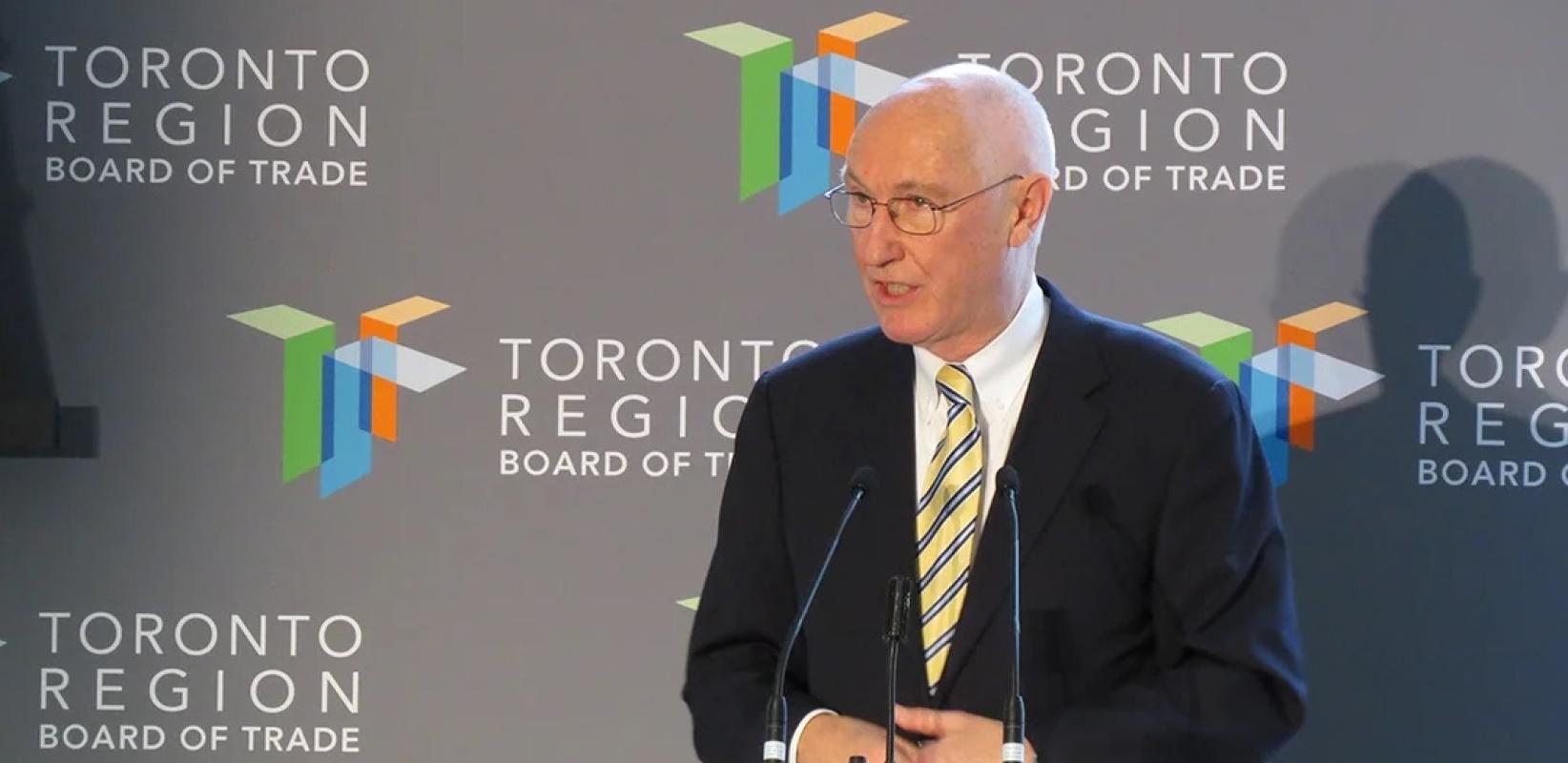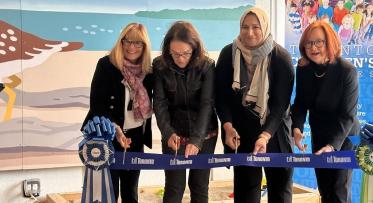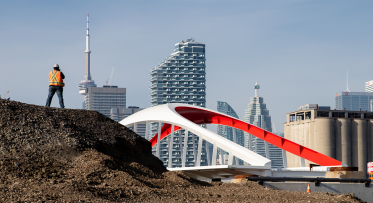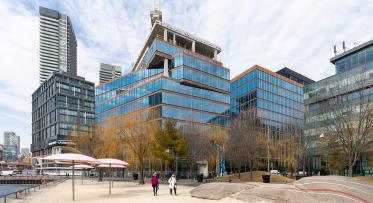John Campbell Speaks to the Toronto Region Board of Trade
Earlier this month, Waterfront Toronto’s President and CEO, John Campbell, gave a speech to business leaders at a Toronto Region Board of Trade luncheon. His remarks touched on the work our agency has done over the last decade and looked ahead at the decade to come. This is an edited transcript of those remarks. (Image courtesy of Toronto Region Board of Trade.)
POSTED: OCTOBER 27, 2014
BY: JOHN CAMPBELL, PRESIDENT & CEO
Fixing our waterfront is not just about making Toronto a better city, building great new communities, and giving the waterfront back to the city. It’s about making Toronto more economically competitive and prosperous for the long-term.
As we hit the half-way mark of Waterfront Toronto’s 20-year mandate, I think back to how the waterfront was used and the role it played in our city’s economy. Decades ago, the waterfront was a mostly industrial area, cut off from the rest of the city and offering only very limited access to citizens and visitors. It was a resource that was woefully underutilized for our changing and growing city.
Today, that is changing as the city grows. The downtown is expanding at a rapid pace. The South Core, where I work, is exploding with growth.
What does this mean to the waterfront? I couldn’t put it any better than this recent Board of Trade Report on regional economic strategy, which says:
Toronto proves itself each year to be one of the most successful city regions in the world, with roughly 120,000 choosing it as their new home annually… numerous global businesses choosing to locate within its borders, and consistently high rankings on quality of life. Toronto stands in an enviable position to promote economic progress.
Right now, people from all over the world are flocking to Toronto’s downtown, looking for economic opportunity. A recent study, called Decoding Global Talent, by the Boston Consulting Group ranked Toronto the eighth-most popular destination for global talent – ahead of San Francisco, Tokyo, Munich and Copenhagen.
Richard Florida – who moved to Toronto for the opportunity – wrote a story about this report for The Atlantic’s CityLab and prefaced the results by saying:
“Over the past couple of decades, talent has supplanted endowments of natural resources and the technological and industrial prowess of large corporations as the source of economic advantage for nations and cities.”
This talent is looking for a place to live that offers a high quality of place and a high quality of life. They want to live and work downtown and enjoy a high-quality urban lifestyle. They want access to jobs, restaurants, cultural amenities, and parks and recreation areas.
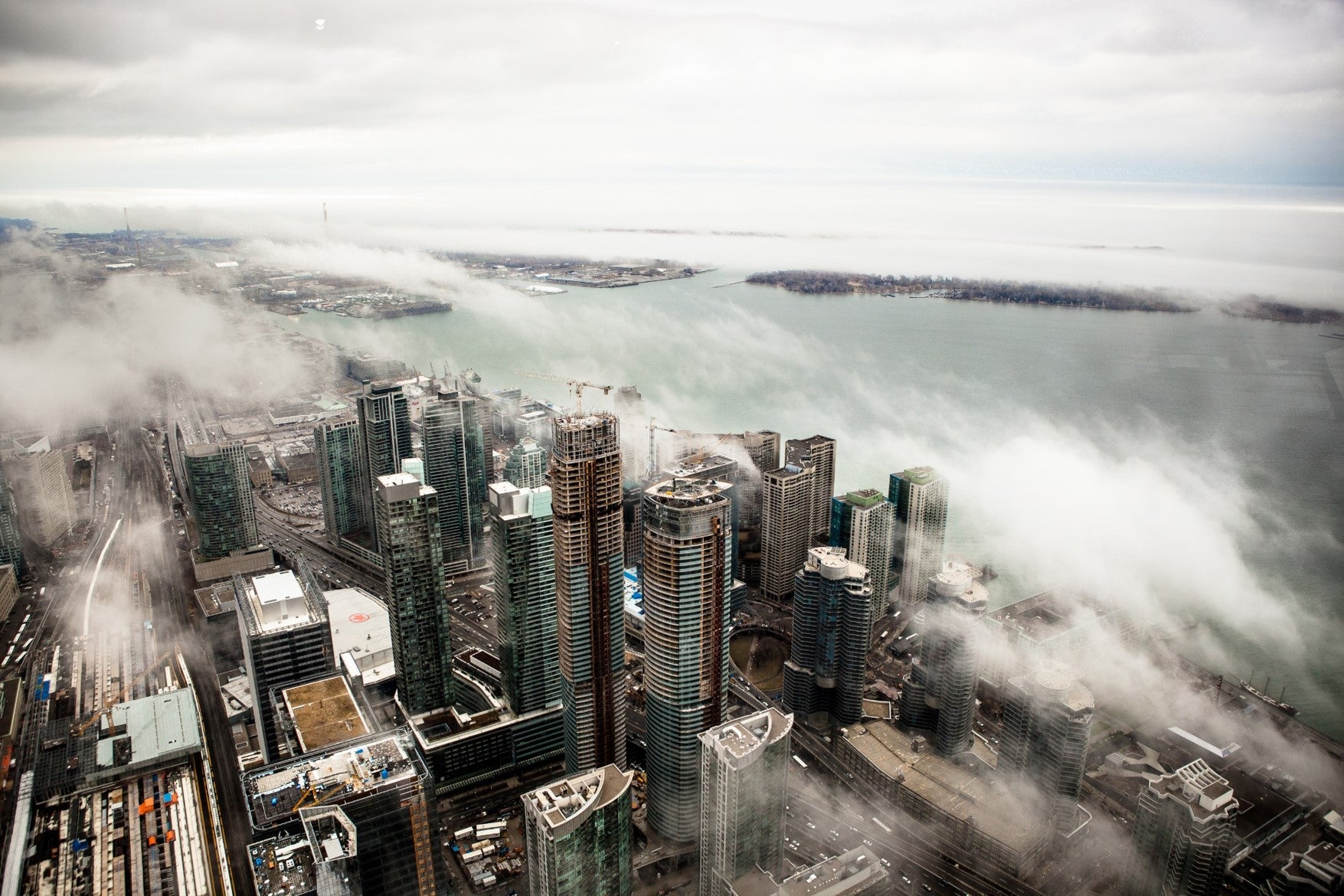
120,000 people move to Toronto each year – and overwhelmingly they want to live downtown with access to jobs, restaurants, cultural amenities, and parks and recreation areas.
This can be a difficult concept for some to get used to: we compete not with Montreal, but with Paris. Not with Ottawa, but with Singapore, London, New York, San Francisco and Barcelona.
For all of us, this means understanding what makes these cities successful. This means understanding how to meet the challenges of building great communities where people want to live – regardless of their level of income – where businesses want to invest and where people want to visit.
It means learning how to build these communities in an innovative way – with the best approaches from around the world – and ensuring excellence in design, sustainability, development, technology and livability. It means learning how to build the right infrastructure into each community so that it provides a solid foundation for long-term and high-value economic growth. That means infrastructure like transit, parks and public spaces, and high-speed and accessible broadband Internet.
What I am describing for you is what Waterfront Toronto is doing in revitalizing our city’s waterfront.
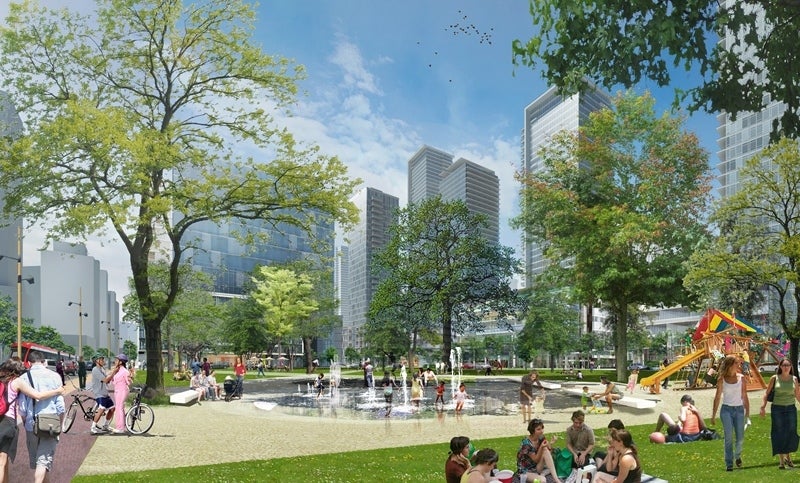
Building transit, parks and public spaces, and high-speed and accessible broadband Internet are a cornerstone of Waterfront Toronto's revitalization plan.
This is a good opportunity for me to remind you of Waterfront Toronto’s mandate. While we were instructed to revitalize the waterfront, we were also left with a set of public policy goals to support, including this one:
Leverage the infrastructure project to deliver key economic and social benefits that enable Toronto to compete aggressively with other top-tier global cities for investment, jobs and people.
So when you think of where the downtown can grow – the remaining areas where we can build new communities – this makes the waterfront something of a last frontier.
It is the last piece of significant land in the downtown, and on the lake, that can be home to these new communities and neighbourhoods.
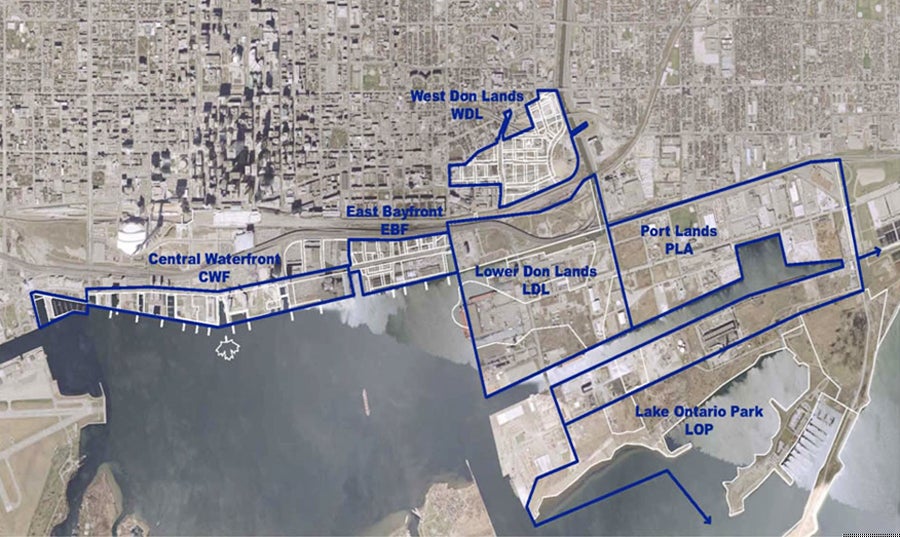
Toronto's waterfront revitalization area is comprised of 800 hectares – about 2,000 acres – of mostly urban brownfield lands. It is the last significant tract of land to be developed in the city.
How the waterfront evolves as a place to live, work and play will be very important in determining how successful Toronto is at attracting this global talent and capital and staying economically competitive over the next century. This is what I think of as a long-term economic play.
We’ve still got a lot of waterfront to work with. The total area being redeveloped is 800 hectares – about 2,000 acres – which translates into an area roughly the size of Toronto’s downtown core, from Bathurst Street to Sherbourne Avenue and Front Street to Bloor Street.
This is the largest urban redevelopment project currently underway in North America and certainly one of the largest waterfront revitalization efforts ever undertaken in the world. That’s important to remember. The size of this project underlines the potential impact it can have on our city and our region.
Toronto’s economic health is also Ontario and Canada’s economic health; this city represents almost half of Ontario’s GDP and about 20 per cent of Canada’s GDP.
We are, in effect, using an infrastructure project to deliver a competitive economic model for Toronto. At heart, what we are doing is both revitalizing Toronto’s waterfront and supporting the kind of physical and human infrastructure that leads to sustainable economic growth. This is the same kind of growth that has seen Toronto become a top-tier global city.
So let me be clear: Waterfront revitalization is good for the economy. And our model is working.
In one way, revitalization is an economic model that goes beyond the traditional public sector model where conventional infrastructure projects create construction jobs.
Our model is based on a few key things. It’s based on the idea that when three levels of government come together and agree on a goal – and agree on how it will be achieved and funded – then it will achieve much more than any one level of government working independently.
The model is also based on the idea that given a mandate and funding, a tri-partite agency like Waterfront Toronto is accountable for producing results. And it’s based on a very simple understanding and allocation of risk:
Waterfront Toronto takes on the risks that the private sector would never take on: big infrastructure pieces like flood protection, parks and public spaces and municipal services. And the private sector – the developers who want to build residential and commercial space on the waterfront – take on the construction risk and market risk associated with building and selling or leasing space.
Again, this model works well. But I came here today to tell you about how this new waterfront is an economic driver for Toronto.
It’s one thing to simply invest a lot of money and hope that some of it trickles down, but it’s another thing to invest money wisely and to invest at the right time, for the right things.
One way to evaluate the effectiveness of Waterfront Toronto’s investments thus far is to look at how they relate to some key drivers of economic competitiveness for Toronto.
For some guidance on this, I have turned to the Toronto Regional Board of Trade’s Scorecard on Prosperity 2014. It ranks Toronto in third place against 23 other global cities. It shows what we are good at and where we need to improve. The Scorecard mentions two key factors that actually make us more competitive:
- Building solid, modern infrastructure
- And attracting human capital
I couldn’t agree more. That’s why we’re delivering critical infrastructure in all of our projects. Infrastructure that enables sustainable development.
And one of the most robust, important and valuable pieces of infrastructure that we’ve built is one that protects more than 200 hectares of the eastern downtown area of Toronto against flooding. This includes parts of Toronto’s financial district and the South Core.
I’m talking about the Flood Protection Landform that we worked with Infrastructure Ontario to build in the West Don Lands. Some of you might recognize it as Corktown Common – an award-winning park – that rests on top of that berm.
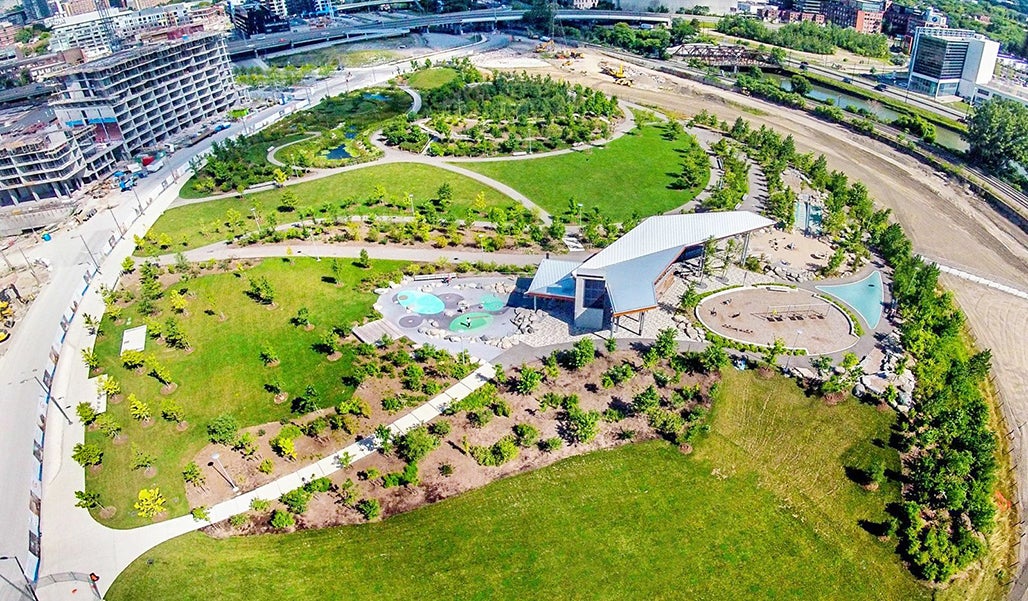
Corktown Common is an 18-acre park built on top of a massive berm that protects part of Toronto's downtown from flooding. (Image courtesy of Spencer Wynn.)
After the damage caused by storms and flooding last summer – in both Toronto and Calgary – we can see why flood protection has taken on a more urgent profile. And given that for every dollar invested in flood protection, governments save five dollars on paying for the damage, it’s a smart investment.
But there’s more flood protection investment required – I’ll get to that shortly.
What other types of infrastructure are we providing? In redeveloping Queens Quay, we have rebuilt all of the underground services to provide power, water, sewage and telecommunications to the area – as we create one of the city’s signature streets. We’re building a dedicated transit corridor to separate the streetcar from auto traffic and we are reconnecting the Martin Goodman Trail.
Further east along Queens Quay, Sherbourne Common is the first park in Canada to integrate an ultraviolet stormwater treatment facility into its design.
That facility will service the entire East Bay Front neighbourhood, which, when built out, will be home to close to 10,000 people.
Sherbourne Common and Corktown Common are great examples of parks as infrastructure. Canada’s Sugar Beach – with its famous pink umbrellas – is another park that should be looked at as a type of community infrastructure.
Sugar Beach is a great combination of park, beach and vantage point – overlooking the Redpath Sugar Refinery. It has become an instant hit – there are few better places in Toronto from which to see the old and the new, the industrial and the modern, the lake and the city.
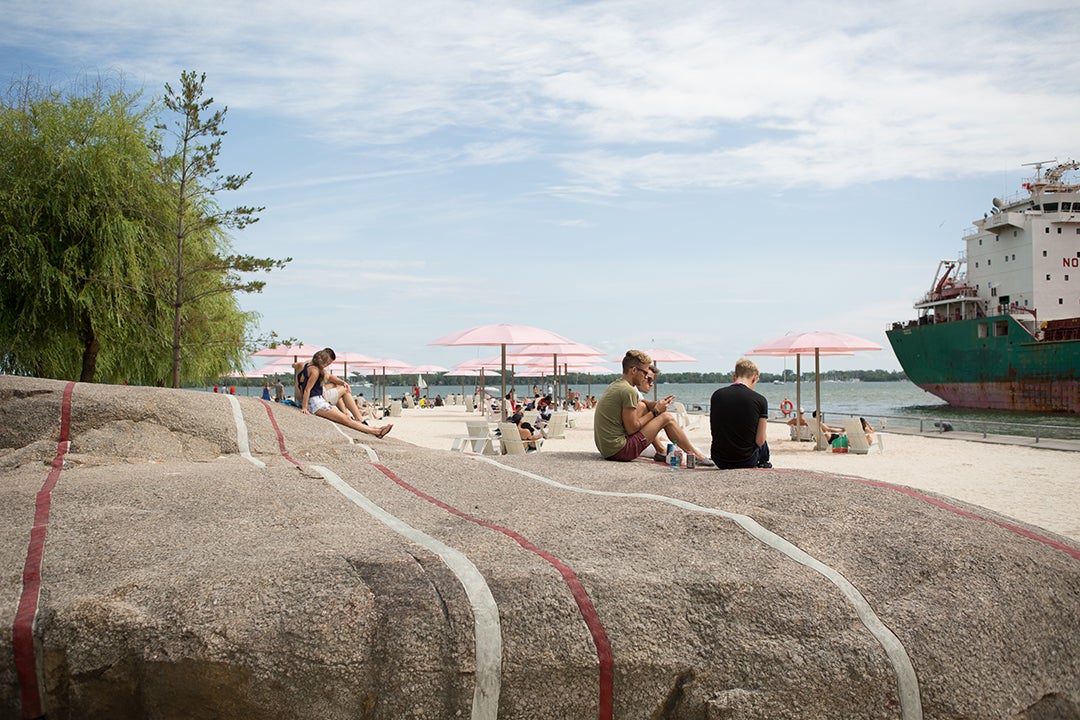
Canada's Sugar Beach – which used to be a parking lot – has created a unique public space with a vantage point for the "theatre of the harbour."
It is a front-row seat to what I call the “theatre of the harbour” – and I’ve heard that area workers leave their desks to catch a glimpse of the freighter as it pulls in to empty its cargo at Redpath.
Even though it is only two acres in size, it has provided a focal point for the area; it has redefined the area in terms of its feel and its playfulness.
It’s no coincidence that the area has seen well over a billion dollars of private sector commitment – and that’s just the beginning.
And on the topic of infrastructure, let’s not forget about digital infrastructure. One of the initiatives that I am most proud of is our low-cost, open access, ultra-broadband network. It will be available to residents, businesses and visitors across our revitalization area. This is a critical and powerful support to Toronto’s growing knowledge economy. Our infrastructure delivers a competitive edge to digital, creative and collaborative businesses that need to attract and retain top talent. As people and companies migrate to our waterfront, they’ll form a hub of collaboration and creativity that will benefit the economies of Toronto, Ontario and Canada.
Let’s not forget that Toronto is already a global centre for film, multimedia and digital media production and creative industries – the same sectors that will make very good use of infrastructure like this.
Just this morning, our broadband partner, Beanfield Metroconnect, announced that its basic service will start at 500Mbps, with no data caps and with the same speed for uploading and downloading – setting a new standard for residential and commercial broadband service in Canada. It shows how digital infrastructure should be considered in the same breath as roads, water, sewers and transit.
This network is being used now by Corus Entertainment and George Brown College. Both of those buildings are focused on technology and innovation, which leads me to what will soon be their neighbour: the Waterfront Innovation Centre.
This will be a purpose-built commercial facility that will provide tenants with a collaborative environment, characterized by a dynamic exchange of information, ideas and innovation. And it will be built without public funds – and built on digital infrastructure funded by the private sector.
And I should also mention that this digital infrastructure is inclusive. Our business model is structured in such a way as to provide very affordable access to the tenants in the area’s affordable rental housing.
This means everyone can benefit from the opportunities for prosperity that the digital economy affords. No-one will be left behind.
Attached to this broadband network will be a powerful community portal and platform to provide residents with social collaboration tools to connect with neighbours, businesses and service providers in the surrounding areas.
It will help them make smarter decisions about everything from the daily commute to their health and wellness. In doing so, it will create communities that will be among the most advanced in the world, setting a new precedent for intelligent city-building.
The importance of this infrastructure cannot be overstated. These tools enable complex projects to be completed faster, buildings to run more efficiently, and residents to access a range of services and opportunities for social interaction.
Another economic benefit from this is property value: property values are higher in areas where broadband is available. Of the more than 12,000 new residential units to be developed in the East Bayfront and West Don Lands, the additional real estate value generated by this initiative could amount to between $20 and $40 million.
A lot of people may not have noticed that we’re building this digital infrastructure. But certainly the New York-based think tank, Intelligent Community Forum has noticed. They monitor 400 cities around the world and prepare an annual list of the Top Intelligent Communities in the World. Toronto has made that list three times in the last decade. This year, partly because of initiatives like the one I just described, Toronto won the prestigious Intelligent Community of Year Award.
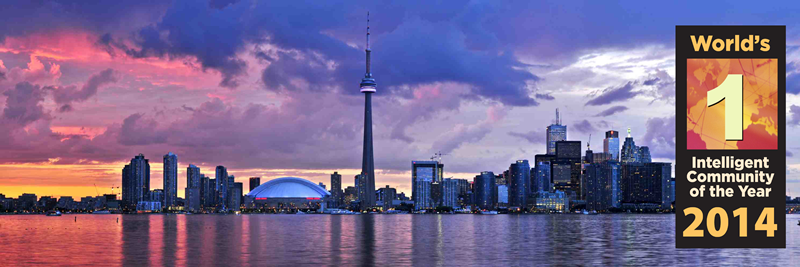
Waterfront Toronto's Intelligent Community initiatives helped the city win the title of Intelligent Community of the Year in 2014.
I’ve talked about infrastructure – now I will talk about that other important goal: attracting human capital. How can we make the city an appealing place to work for the highly-educated and skilled workers we need to keep our economy healthy and growing?
Creating a high quality of place is central to our mission. By ensuring our communities are highly-sustainable, beautifully-designed and connected, we are building new areas that people will want to call home.
In an era where talent and capital chooses where to locate, quality of life is a key factor in economic decisions. Just look at Coca-Cola, which last year moved its headquarters from East York to downtown – because of the convenience for its employees, as well as access to all of downtown’s amenities. Downtown is where the talent pool is.
That’s why our plans call for new waterfront communities that contain 40,000 residential units, one million square metres of employment space and 300 hectares of parks and public spaces.
Our new communities are planned and designed to encourage active transportation such as walking and biking – helping to reduce dependency on the automobile and encourage public transportation. And, importantly, these communities are close to employment opportunities.
I can’t emphasize enough how important this quality of life is to our city’s future. All of these factors, all of these elements, combine together to build the quality of life that is sought by talent and capital from all around the world.
And it almost goes without saying, that all across the world, waterfront areas are highly-desirable places to live. So the new communities we are building will be seen as some of the best places in the city to live.
Since I’m talking about economic growth, I should also point out that Waterfront Toronto is providing strong economic returns.
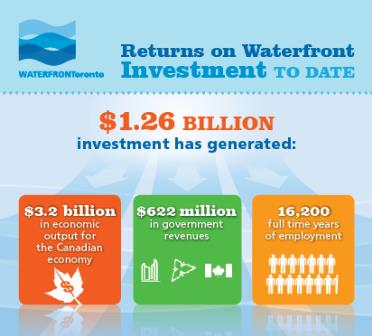
Our initial $1.26 billion investment to date has stimulated over $3.2 billion in total economic output to the Canadian economy. We have generated total government revenues of over $600 million.
Thus far, our projects and investments have generated over 16,000 full‐time years of employment.
In addition, Waterfront Toronto has more than doubled the value of waterfront investment to date by attracting initial development projects valued at more than $2.6 billion to the first new waterfront neighbourhoods of East Bayfront and West Don Lands. These in turn will generate over $800 million more in government revenues.
What’s more, our revitalization work has been, in part, a catalyst for $9.6 billion in private-sector investment and development just outside the lands we directly oversee.
Today, there are 44 recent and planned development projects on privately-owned lands across the waterfront and in adjacent neighbourhoods close to where Waterfront Toronto has invested.
The proximity of these private-sector developments to the essential community infrastructure – parks and public spaces, waterfront and riverfront access, transit, flood protection and brownfield remediation – is creating significant value.
They will contribute an additional $8.9 billion to the Canadian economy, almost 95,000 years of employment and $4.7 billion in labour income. And let’s not forget the government revenue of $3.4 billion that comes from this development.
And, we’re just getting started.
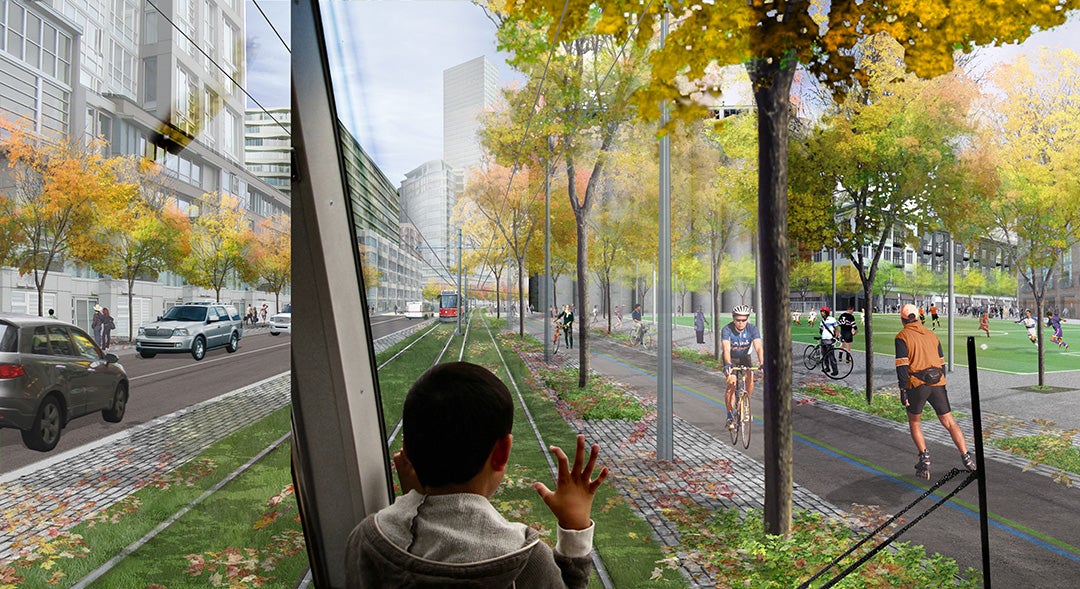
The next phase of Toronto's waterfront revitalization includes the Port Lands, which requires investment in flood protection and public transit.
So what comes next for Waterfront Toronto? And how will our plans for the remainder of our mandate build on the economic value we’ve created?
Again, I will refer back to the two key themes: infrastructure and attracting human capital. Our next plan calls for $1.65 billion in public investment that would substantially complete waterfront revitalization and help to create billions in additional economic value.
Our future plans – which we call Waterfront Toronto 2.0 – can be divided into four buckets. They represent an approach that selects the important public investments to minimize risk and attract private sector investment. Those buckets are flood protection, transit, municipal services and infrastructure, and parks and public spaces.
The single biggest project that remains is to unlock the value of the Port Lands. It represents an unprecedented opportunity – few developed cities have the opportunity to revitalize a massive, 1,000-acre brownfield site this close to downtown.
We have a great vision for this area, which is supported by our partners – the City and the Toronto and Region Conservation Authority.
Our vision for the Port Lands begins with a new river – the Don, released from its man-made boundaries, and allowed to become a naturalized river mouth. The naturalized Don River mouth will be the focus of a new waterfront park and the center of a new, green community, connected to the waterfront and plugged into downtown.
It will enhance water and land habitat for natural species and create the potential to re-establish wetlands in the area that were lost 100 years ago.
It will be an urban port city, with a unique Shipping Channel that combines the historic industrial uses of a port with a sustainable community and modern commercial activity.
And, importantly, the new river will provide flood protection for the Port Lands, South Riverdale and Leslieville areas – which are subject to some of the greatest flood risks in the city.
The value to the city from this project in terms of future development is worth well over $5 billion.
And, it will also help to unlock the former Unilever site on the east side of the Don River – what some are referring to as Toronto’s Canary Wharf. There are some big plans for this site that would see a very large commercial development that would tie into existing and planned transit networks – just what the city needs, according to the Board of Trade.
This is infrastructure that supports long-term growth.
One of those planned transit lines is also a part of our remaining work – the East Bayfront Light Rapid Transit (LRT) line. It will go from Union Station across Queens Quay East and eventually serve the entire eastern waterfront and the Port Lands, including the Unilever site.
The East Bayfront LRT will deliver significant economic benefits to the waterfront and Toronto, by providing rapid transit to open up and connect our new waterfront communities. It acts as a catalyst for continued private sector residential and commercial investment on the waterfront and surrounding areas, which, in turn, creates employment opportunities. It will exponentially increase the return on investment to governments from waterfront revitalization, including higher tax returns to government.
In all of our planning work, we seek to create long-term transit solutions that will meet the needs of not only the communities that we are designing and building today, but the waterfront communities that will be built in the future. The East Bayfront LRT has gone through a full Environmental Assessment, and we are currently working with our government partners to secure funding for this project.
In two of the Board’s recent reports – the Scorecard on Prosperity and the Toward a Toronto Region Economic Strategy – the Board referenced how transportation networks play a powerful role in economic development.
Let me quote from one of these reports:
“When making decisions on transportation projects, it means giving strong weight to criteria like connectivity to major employment hubs and the potential for high-value commercial and residential development around major transportation hubs.”
And as I mentioned, our future projects include more infrastructure: municipal services, parks and public realm projects that will ensure these waterfront neighbourhoods are appealing places to live, work and play. These projects also help set the table for billions of private sector dollars.
Our work is showing Toronto and the world that this is a city worth moving to and investing in. Our work shows that we can do this – and we can do it well.
The transformed and revitalized Waterfront will be home to over 100,000 residents and support 40,000 new jobs. The reinvestment in our waterfront is an engine for economic growth.
When the vision for the waterfront is fully realized, it will provide lasting economic benefits for our city, province and country by creating new employment opportunities, attracting private investment and drawing tourism dollars. I encourage all you to get informed and get engaged on waterfront revitalization. So when you think of the waterfront, think not just of parks and new communities – but think of how it is directly supporting the long-term competitiveness of this amazing city.
We’re not done yet – but the visible transformation of the waterfront is there for all to see… The waterfront belongs to all of us. Its success is our collective success, as Canadians, Ontarians and Torontonians. When three governments agree on what needs to be done, and give us a mandate – it works.
I am very proud to be part of this extraordinary endeavor, one that is building a strong economic model for a better and more competitive city.
Thank you very much.

